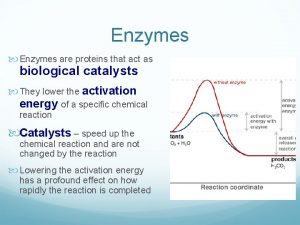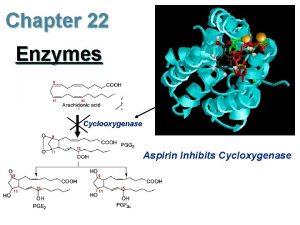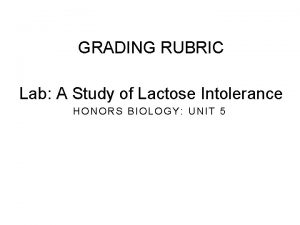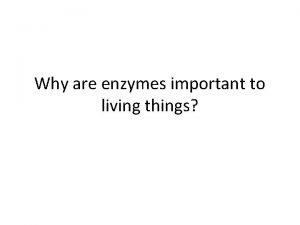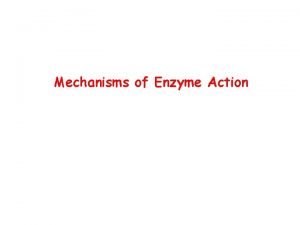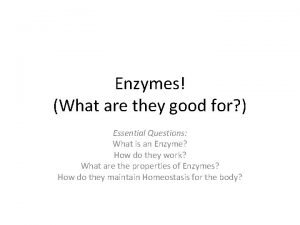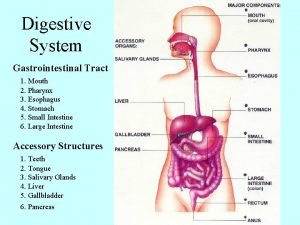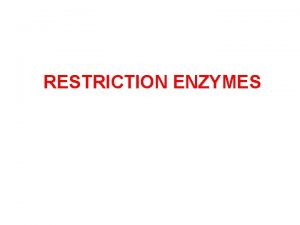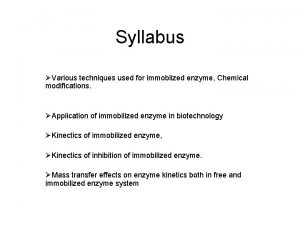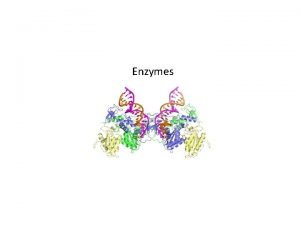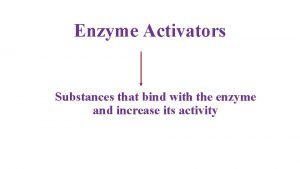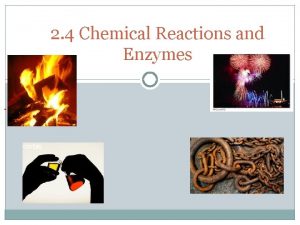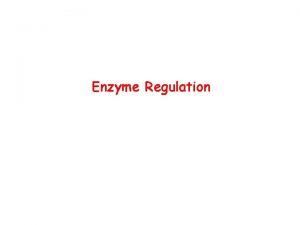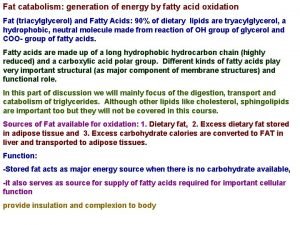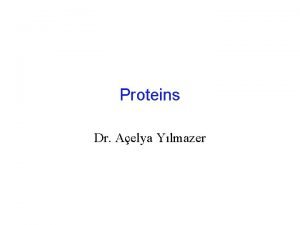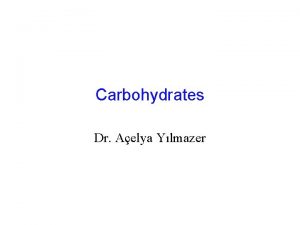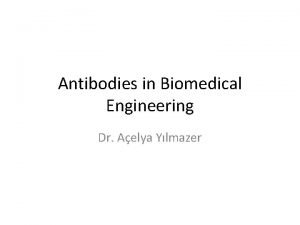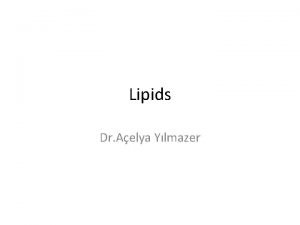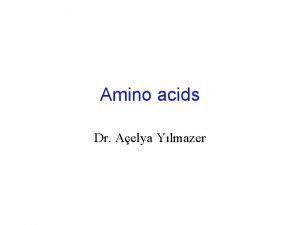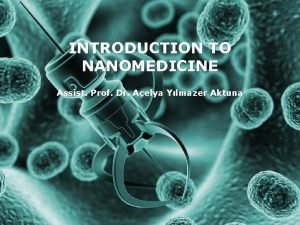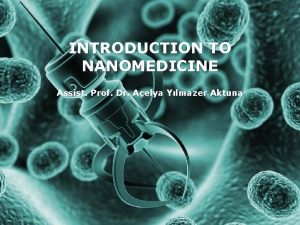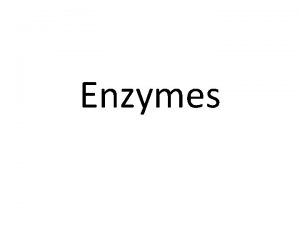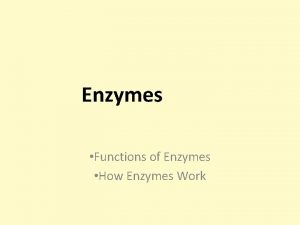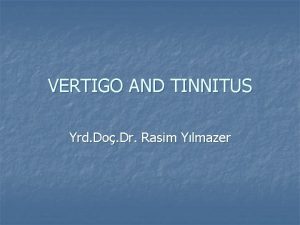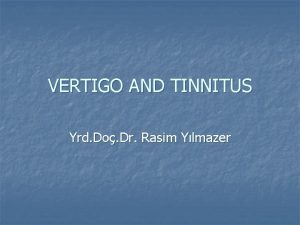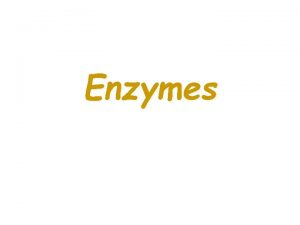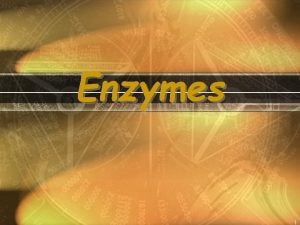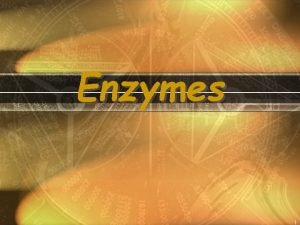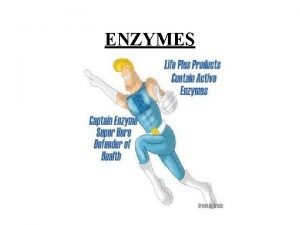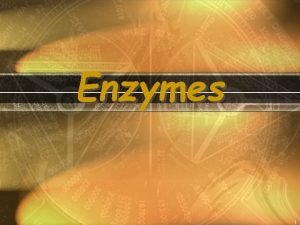Enzymes Dr Aelya Ylmazer What are Enzymes Enzymes






















- Slides: 22

Enzymes Dr. Açelya Yılmazer

What are Enzymes? • Enzymes are catalytically active biological macromolecules • Most enzymes are globular proteins, however some RNA (ribozymes, and ribosomal RNA) also catalyze reactions • Study of enzymatic processes is the oldest field of biochemistry, dating back to late 1700 s • Study of enzymes has dominated biochemistry in the past and continues to do so

Why Biocatalysis? • • Higher reaction rates Greater reaction specificity Milder reaction conditions Capacity for regulation • Metabolites have many potential pathways of decomposition • Enzymes make the desired one most favorable

Enzymatic Substrate Selectivity No binding Binding but no reaction Example: Phenylalanine hydroxylase

Cofactors: Some enzymes need inorganic ions to get activated

Coenzyme: Organic cofactors Holoenyzme: catalytically active enzyme and linked coenzyme or cofactor katalitik olarak aktif enzim ve bağlı koenzim/kofaktör. Apoenzyme(apoprotein): protein part of the holoenzim

‘-ase’ • DNA polimerase; ürease Latin names: pepsin

Enzyme-Substrate Complex • Enzymes act by binding substrates – the non-covalent enzyme substrate complex is known as the Michaelis complex – allows thinking in terms of chemical interactions – allows development of kinetic equations

Transition State Theory • Slow reactions face significant activation barriers that must be surmounted during the reaction –transition state theory is applicable for catalysis –rate constants and free energies can be related

Rate Acceleration • The enzyme lowers the activation barrier compared to the uncatalyzed aqueous reaction • In theory, the enzyme may also facilitate the tunneling through the barrier. This may be important for electrons.


How to Lower G ? Enzymes organizes reactive groups into proximity • Uncatalyzed bimolecular reactions: two free reactants single restricted transition state conversion is entropically unfavorable • Uncatalyzed unimolecular reactions: flexible reactant rigid transition state conversion is entropically unfavorable for flexible reactants • Catalyzed reactions: Enzyme uses the binding energy of substrates to organize the reactants to a fairly rigid ES complex Entropy cost is paid during binding Rigid reactant complex transition state conversion is entropically OK

How to Lower G ? Enzymes bind transition states best • The idea was proposed by Linus Pauling in 1946: – enzyme active sites are complimentary to the transition state of the reaction – enzymes bind transition states better than substrates – stronger interactions with the transition state as compared to the ground state lower the activation barrier Largely H‡ effect

Illustration of TS Stabilization Idea: Imaginary Stickase

How is TS Stabilization Achieved? – acid-base catalysis: give and take protons – covalent catalysis: change reaction paths – metal ion catalysis: use redox cofactors, p. Ka shifters – electrostatic catalysis: preferential interactions with TS

What is Enzyme Kinetics? • Kinetics is the study of the rate at which compounds react • Rate of enzymatic reaction is affected by – Enzyme – Substrate – Effectors – Temperature

Why Study Enzyme Kinetics? • • • Quantitative description of biocatalysis Determine the order of binding of substrates Elucidate acid-base catalysis Understand catalytic mechanism Find effective inhibitors Understand regulation of activity

Two-substrate Reactions • ATP + glukoz heksokinaz ADP + glukoz 6 -fosfat • Kinetic mechanism: the order of binding of substrates and release of products • When two or more reactants are involved, enzyme kinetics allows to distinguish between different kinetic mechanisms – – Sequential mechanism Ping-Pong mechanism

Sequential Kinetic Mechanism We cannot easily distinguish random from ordered Random mechanisms in equilibrium will give intersection point at y-axis Lines intersect

Enzyme Inhibition Inhibitors are compounds that decrease enzyme’s activity • Irreversible inhibitors (inactivators) react with the enzyme - one inhibitor molecule can permanently shut off one enzyme molecule - they are often powerful toxins but also may be used as drugs • Reversible inhibitors bind to, and can dissociate from the enzyme - they are often structural analogs of substrates or products - they are often used as drugs to slow down a specific enzyme • Reversible inhibitor can bind: – To the free enzyme and prevent the binding of the substrate – To the enzyme-substrate complex and prevent the reaction

Classification of Reversible Inhibitors • Reversible inhibitor can bind: – To the free enzyme and prevent the binding of the substrate – To the enzyme-substrate complex and prevent the reaction

Regulatory Enzymes • Cellular metabolism have seqeuntial pathyways and enzymes that work together. Such enzymatic systems should be regulated. . • Regulatory enzymes regulate activity through • Reversible modification allosteric enzymes • Covalent modification
 Mikael ferm
Mikael ferm Enes ylmazer
Enes ylmazer Structure of enzymes
Structure of enzymes Enzymes in biological washing powder
Enzymes in biological washing powder Protein that acts as biological catalyst
Protein that acts as biological catalyst Classification of enzymes
Classification of enzymes Enzymes and lactose intolerance lab answers
Enzymes and lactose intolerance lab answers Why are enzymes important to living things
Why are enzymes important to living things Transition state
Transition state Kscience enzymes
Kscience enzymes Glucose absorption in intestine
Glucose absorption in intestine Mechanism of restriction enzyme
Mechanism of restriction enzyme Immobilized enzymes
Immobilized enzymes Chapter 12 enzymes the protein catalyst
Chapter 12 enzymes the protein catalyst Section 2-4 chemical reactions and enzymes
Section 2-4 chemical reactions and enzymes What is made of amino acids
What is made of amino acids Chemical reactions that release energy are called
Chemical reactions that release energy are called Succinate dehydrogenase inhibitor malonate
Succinate dehydrogenase inhibitor malonate What is released or absorbed whenever chemical
What is released or absorbed whenever chemical Covalent modification
Covalent modification What are enzymes in food ingredients
What are enzymes in food ingredients Enzymes
Enzymes Pancreatic enzymes
Pancreatic enzymes




